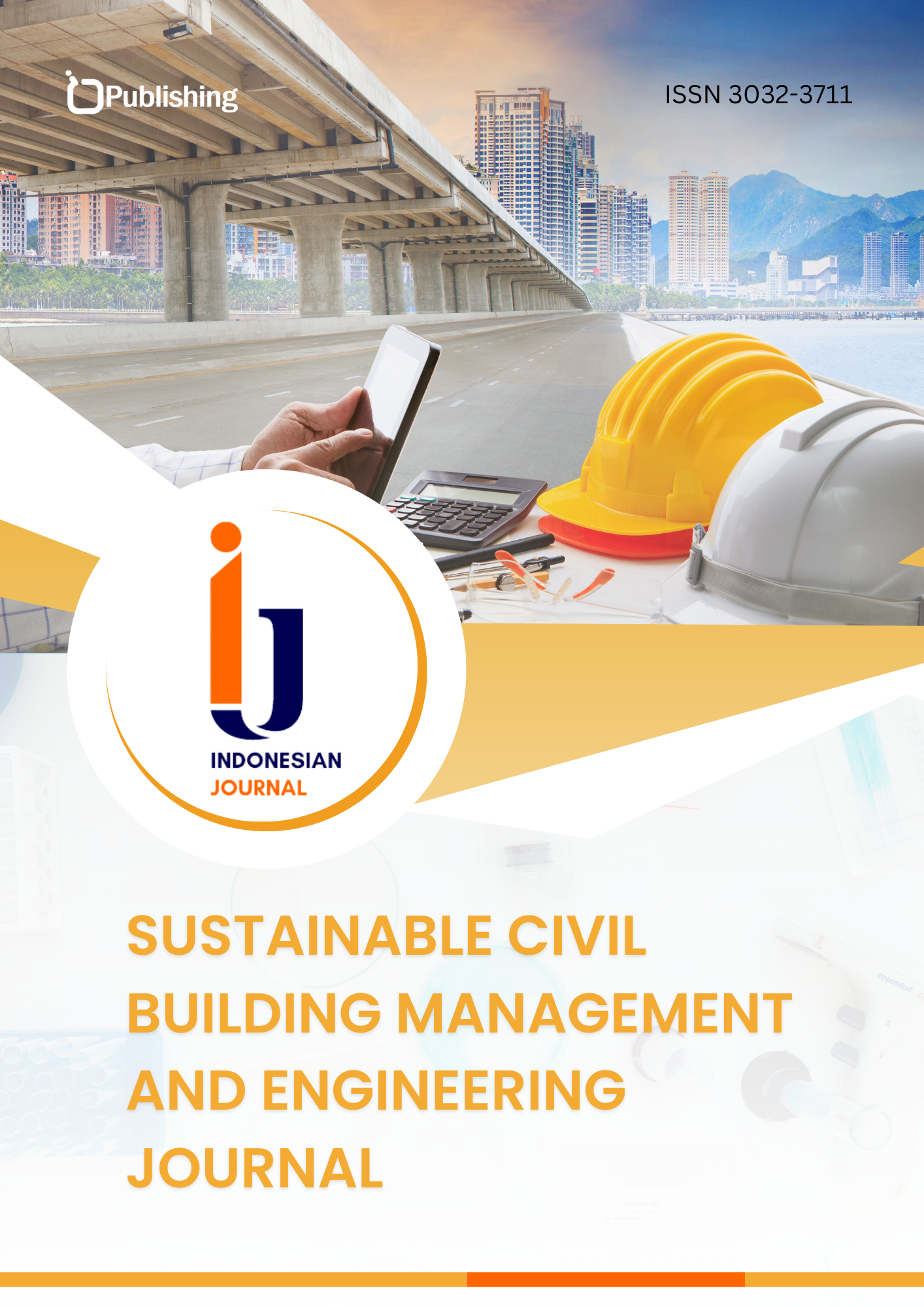Volume and Cutting Optimization of Reinforcing Steel in Construction of a Satpol PP Building Project
DOI:
https://doi.org/10.47134/scbmej.v1i3.2697Keywords:
Autodesk Revit, Construction Management, Reinforcement VolumeAbstract
The world of construction is very dependent on technology, especially in the era of the industrial revolution which demands efficiency and competitiveness. The use of BIM (Building Information Modeling) technology supported by Autodesk Revit software enables more effective and efficient project planning and implementation. One application of BIM is in planning reinforcing steel requirements. To overcome material waste which often occurs due to less than optimal cutting of reinforcing steel, material management with a bar bending schedule and the use of BIM is an important solution. In the Satpol PP Building Construction Project in Bantul Regency by PT Quinad Bahana Indonesia, this new method with software was applied to correct cutting of reinforcing steel, reduce waste and increase construction efficiency. This research method includes data collection, 3D BIM modeling, comparing work volume using Autodesk Revit and conventional. After getting the reinforcing steel volume from the Autodesk Revit software, continue by entering the volume data into the BIM to obtain optimal reinforcing steel cutting patterns. The research results show that the use of Autodesk Revit software for column and beam work results in an overall difference of 11%. The volume resulting from Revit quantity take-off is less than manual analysis. Based on waste level calculations, the average value of waste level is 0.97%. This proves that the BIM is effective in reducing material waste on construction projects. Apart from reducing material waste, the BIM is also able to optimize reinforcing steel cuts.
References
Alwi, S., Hampson, K., & Mohamed, S. (2002). Waste in the Indonesian construction projects. https://eprints.qut.edu.au/secure/00004163/01/CIB_W107_-
Andika, R. U. (2022). Abstrak-Raihan Umar Andika-H1B018037-Skripsi-2022.
Atmaja, J., Adibroto, F., Hidayah, N., Teknik Sipil, J., Negeri Padang, P., Limau Manis, K., & Studi
Manajemen Rekayasa Konstruksi, P. (2020). Optimasi Pemotongan Besi Tulangan Pada Pekerjaan Struktur Menggunakan Metode Linear Programming.
Din, Z. U. (2020). Strategies of BIM Application with Traditional Project Delivery Method: A Case of Building Construction Industry in Pakistan. Construction Research Congress 2020: Computer Applications - Selected Papers from the Construction Research Congress 2020, 613–621. DOI: https://doi.org/10.1061/9780784482865.065
Eastman, C., Eastman, C. M., Teicholz, P. et al. (2011). BIM Handbook: A Guide to Building Information Modeling for Owner, Manager, Designer, Engineers and Contractor. Hoboken, NJ
Endro Yuwono, B., Rayshanda, R., & Raflis. (2018). Manfaat Penggunaan Building Information Modelling (BIM) pada Proyek Konstruksi Sebagai Media Komunikasi Stakeholders.
Ervianto, W. I. (2010). Implementasi Pembangunan Berkelanjutan Tinjauan pada Tahap Konstruksi.
Ervianto, Wulfram I. 2005. Manajemen Proyek Konstruksi. Yogyakarta.
Gaspersz, V. (2001). Total Quality Management. Jakarta: PT. Gramedia Pustaka Utama.
Gloud, Frederick E., Joyce, Nancy E. 2011. Construction Project Management. United State of America.
Laurentius Wahyudi; Sjahril A. Rahim. 1997. Struktur beton bertulang : standar baru SNI T-15-1991-03. Jakarta.
Lien, L. C. (2023). BIM-based steel reinforcing bar detail construction design and picking optimization. Structures, 49, 520–536. https://doi.org/10.1016/j.istruc.2023.01.004 DOI: https://doi.org/10.1016/j.istruc.2023.01.004
Liu, J. (2020). Towards automated clash resolution of reinforcing steel design in reinforced concrete frames via Q-learning and building information modeling. Automation in Construction, 112. https://doi.org/10.1016/j.autcon.2019.103062 DOI: https://doi.org/10.1016/j.autcon.2019.103062
Liu, P. (2023). Automated clash resolution for reinforcement steel design in precast concrete wall panels via generative adversarial network and reinforcement learning. Advanced Engineering Informatics, 58. https://doi.org/10.1016/j.aei.2023.102131 DOI: https://doi.org/10.1016/j.aei.2023.102131
Muka, W., Widyatmika, A., Made, I., & Antara, N. (2019). Analisis Perbandingan Waste Besi Tulangan Metode Konvensional dengan Software BIM. DOI: https://doi.org/10.26623/teknika.v15i2.2852
Pozo, J. D. (2020). Quantitative assessment of nonlinear macro-models for global behavior and design of planar RC walls. Engineering Structures, 224. https://doi.org/10.1016/j.engstruct.2020.111190 DOI: https://doi.org/10.1016/j.engstruct.2020.111190
Putri, J. E. Y. (2023). Embodied carbon analysis on multi-story building using flat slab and conventional slab system. E3S Web of Conferences, 445. https://doi.org/10.1051/e3sconf/202344501037 DOI: https://doi.org/10.1051/e3sconf/202344501037
Rohmah, I. M. N. (2023). Analisis Perbandingan Perhitungan Volume Struktur Antara Building Information Modelling dengan Metode Konvensional pada Proyek Design & Build Pentaan Kawasan Pura Besakih.
Sepfian Dwi Riyanto, M., Solikin, M., Yani Pabelan Kartasura Tromol Pos, J. A., & Tengah, J. (2023). Prosiding Seminar Nasional Teknik Sipil 2023 Analisis Perbandingan Waste Metode Distribusi dengan Software BIM pada Pekerjaan Penulangan Pilecap (Studi Kasus:Proyek XYZ Semarang).
Smith, Dana K., Tardif, Michael. 2009. Building Information Modeling: A Strategic Implementation Guide for Architects, Engineers, Constructors, and Real Estate Asset Managers. Hoboken, New Jersey. DOI: https://doi.org/10.1002/9780470432846
Suhana, M. (2021). S1-2021-415222-abstract.
Tsakanika, E. (2022). The Restoration Proposal for the 4-storey Load Bearing Timber Structure of Matsopoulos Wheat Mill in Trikala (Greece). Lecture Notes in Civil Engineering, 209, 790–803. https://doi.org/10.1007/978-3-030-90788-4_61 DOI: https://doi.org/10.1007/978-3-030-90788-4_61
Walraven, J. (2021). Significance of reinforcement corrosion for modelling the behaviour of existing concrete structures (Key-note lecture). Fib Symposium, 239–249.
Zain, H. A. (2022). Abstrak-Hafizh Abdullah Zain-H1B017020-Skripsi-2022. DOI: https://doi.org/10.1007/978-981-16-4921-9_232-1
Zimmert, F. (2023). Free-form reiinforced concrete, prestressed concrete and composite components: Calculation of cross-section values. Beton- Und Stahlbetonbau, 118(5), 341–352. https://doi.org/10.1002/best.202200110 DOI: https://doi.org/10.1002/cend.202300010
Downloads
Published
How to Cite
Issue
Section
License
Copyright (c) 2024 Quini Athaya Putri, Fajar Sri Handayani, Setiono Setiono

This work is licensed under a Creative Commons Attribution 4.0 International License.










